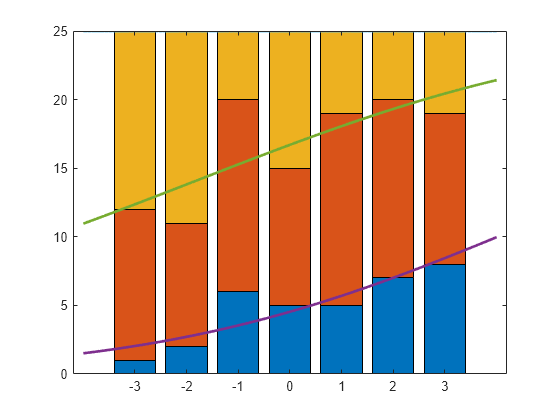mnrval
(Not recommended) Multinomial logistic regression values
mnrval is not recommended.
Instead, use fitmnr
to create a MultinomialRegression model object and then use the predict
object function. (since R2023a) For more information see Version History.
Syntax
Description
pihat = mnrval(B,X)X, and the coefficient estimates,
B.
pihat is an
n-by-k matrix of predicted
probabilities for each multinomial category. B is the vector
or matrix that contains the coefficient estimates returned by mnrfit. And X is
an n-by-p matrix which contains
n observations for p
predictors.
Note
mnrval automatically includes a constant term in
all models. Do not enter a column of 1s in X.
[
also returns 95% error bounds on the predicted probabilities,
pihat,dlow,dhi]
= mnrval(B,X,stats)pihat, using the statistics in the structure,
stats, returned by mnrfit.
The lower and upper confidence bounds for pihat are
pihat minus dlow and
pihat plus dhi, respectively.
Confidence bounds are nonsimultaneous and only apply to the fitted curve, not to
new observations.
[
returns the predicted probabilities and 95% error bounds on the predicted
probabilities pihat,dlow,dhi]
= mnrval(B,X,stats,Name,Value)pihat, with additional options specified by one
or more Name,Value pair arguments.
For example, you can specify the model type, link function, and the type of probabilities to return.
[
also computes 95% error bounds on the predicted counts yhat,dlow,dhi]
= mnrval(B,X,ssize,stats)yhat,
using the statistics in the structure, stats, returned by
mnrfit.
The lower and upper confidence bounds for yhat are
yhat minus dlo and
yhat plus dhi, respectively.
Confidence bounds are nonsimultaneous and they apply to the fitted curve, not to
new observations.
[
returns the predicted category counts and 95% error bounds on the predicted
counts yhat,dlow,dhi]
= mnrval(B,X,ssize,stats,Name,Value)yhat, with additional options specified by one or more
Name,Value pair arguments.
For example, you can specify the model type, link function, and the type of predicted counts to return.
Examples
Input Arguments
Name-Value Arguments
Output Arguments
References
[1] McCullagh, P., and J. A. Nelder. Generalized Linear Models. New York: Chapman & Hall, 1990.


